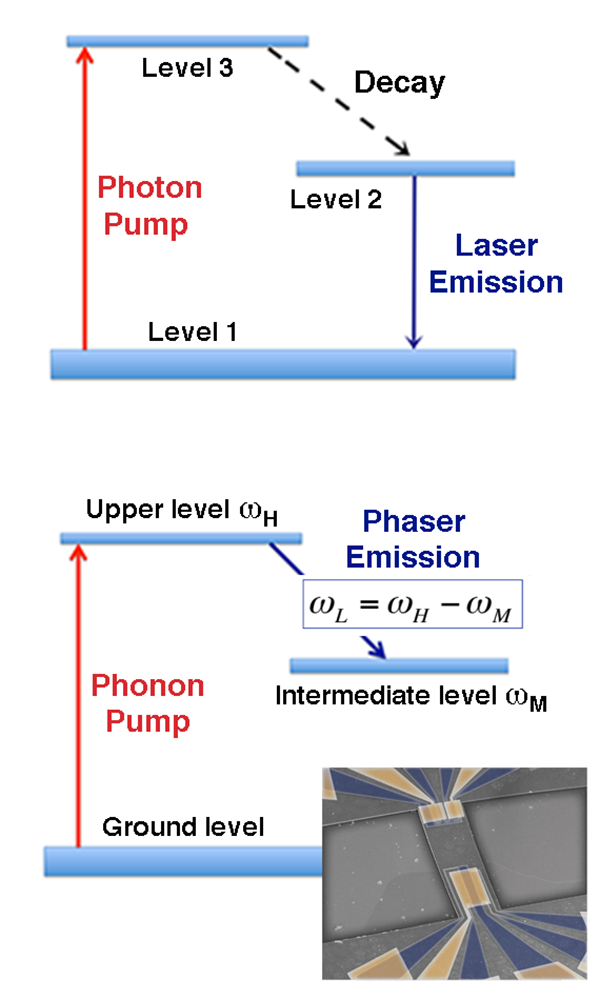aNewDomain.net — Physicists say they’ve reached a new milestone in tech. It’s one that officially marks the entry of the Trekker term “phaser” into real world science, but that’s not the big deal. Essentially, they say they have created the first purely mechanical architecture for creating a sound-based laser — they call it a “phaser” — that works like and would be constructed in much the same way regular light, or photo- based, lasers are. But minus the photons.
That means there are all kinds of real world applications at hand — many of them at this point so cutting edge as to be unimaginable, analysts say.
Invention is the mother of necessity, after all. Figuring out how to build phonon phasers, sound lasers or phonon beams is going to be the first step on the way to real testing and real adoption. And the first step to coming up with real and novel ideas on what to do with such a thing.
The first phonon laser demonstration — let’s settle on the term phaser for this sound laser — arrived on the scene just in 2010. And laser technology is only 50 or so years old. In an empirical science such as physics, this is rapid, mind-blowing progress.
What’s a Phonon?
What we’re talking about here is a laser (a phaser) made of so-called phonons — think of them as sound particle equivalents to light. Traditional lasers — laser is a term short for Light Amplification by Stimulated Emission of Radiation — exclusively rely on photons How to mix it up with another particle or wave? That was the question. In 2010, physicists demonstrated the first laser that similarly concentrated bits of sound into a tight beam the way lasers do with light particles. But there were problems — mainly as a result of architecture that involved having to deal with sound waves, phonoms, and photons, in the same scenario.
Now physicists have crossed a major milestone and solved a critical piece of the puzzle. This is according to the NTT physicists who’ve now published a new architecture for building a non-optical sound-based laser in a paper, called Phonon Lasing in an Electromechanical Resonator in the Mar. 18 version of the American Physical Society’s journal Physical Review Letters.
In the APS open to non-subscribers journal Physics, José Tito Mendonça provided the following description and background today. It is readable in place below.
Phasers Sound Lasers Phonoms Explainer in Full Physics.6.32 via Physics, via anewdomain.net
Mendonça , a physicist at the Instituto Superior Técnico in Portugal, says the innovation from the NTT researchers led by Mahboob, et al, of Japan, reveals a stunning step forward toward the creation of sound-based lasers — phasers based on phonons.
He writes:
In the last decade, the realization of a phonon laser has been pursued using di?erent approaches, involving … semiconductor quantum wells … nanomechanical devices … nanomagnets … single trapped ions … or a laser-cooled gas …
But it wasn’t until 2010 until truly “coherent” laserbeam quality phonon emission was demonstrated using optical microcavities to stimulate ” acoustic emission in the range of hundreds of megahertz … and in the terahertz range,” Mendonça says. Other optical pumping methods were available, but many physicists believed that an architecture involving optical pumping and optics tech could hamper development of the real McCoy. Physicists were looking for a purely mechanical phonon laser architecture to get around problems that had to use both phonons and photons and other complicated schemes.
Now, with today’s announcement from the NTT researchers, we see a major breakthrough. Possible applications include security probes but, physicists common, the potential uses of such a device likely are so far unimaginable.
The development of a purely mechanical architecture for phonon lasers “would pose a major breakthrough. Now, the paper of Mahboob et al. reports a significant step towards this goal. The authors create a purely mechanical system of three energy levels that is reminiscent of a three-level laser scheme,” Mendonça adds.
For all you physics geeks, here is a diagram of that architecture, as printed in Physics. Is this your area of expertise? We’d love your comments and ideas on this development — especially ideas on how sound lasers could best be employed in the future. And not a sci-fi future, either.
This is how it works. For aNewDomain.net, I’m Gina Smith.

Phonon Phaser Explainer Image: Physics













Very insightful
Thank you, Richard, where are you these days. That Genomics Age book was a precious project you gave me, favorite of all my books, and I feel like I owe you big. You’re a GREAT writer. Want to come play at anewdomain.
So I work with Layer1 physics and physical transmission medium errata almost every week.
My favorite metaphor for the Erbium Doped Fiber Amplifier (EDFA) signal regeneration is to think of anthropomorphized photons coming in after hundreds of kilometers or transmission tired and wiped out.
But like a relay race there are the exicted photons waiting in the Faraday cage to take the baton for the next leg and race away when the data arrives creating a perfect digital copy of the bit stream from a degraded one.
Before this phone companies used amplifiers and they amplified noise and artifacts as well as your voice so there was a high Signal to Noise ratio and you found yourself yelling to your grandmother in California so she could hear you over the ambient buzz of noise.
And the inexorable march of technology continues.
Richard, I’m really interested in brainstorming possible applications besides the garden variety security app with this thing. Ideas?
gs